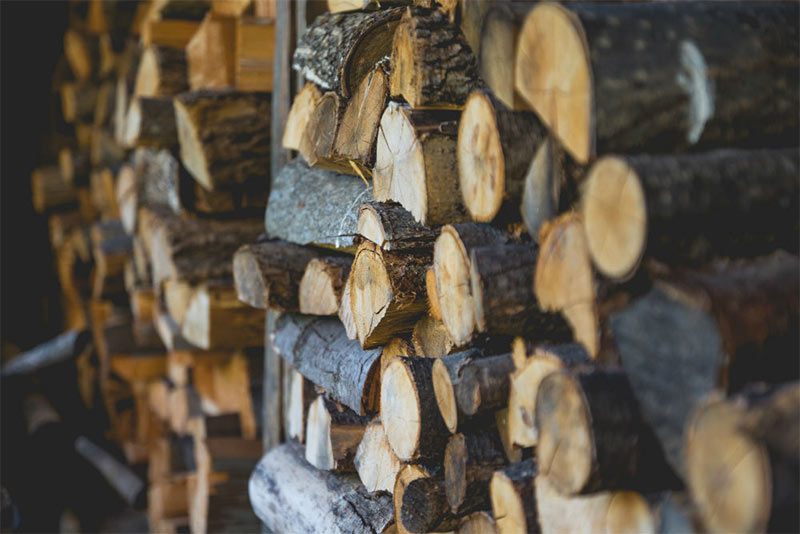
There’s nothing quite like having a real fire in your home. Whether you opt for an open fireplace or a stove, the appeal lies in the immediate warmth and the simple connection with the natural world that a central heating radiator simply cannot compete with. In terms of homeliness and cosiness, surely there’s nothing better than sitting in front of a roaring fire with a good book and a nice glass or red wine, especially when it’s cold and miserable outside.
Thankfully, lighting a fire is not rocket science. That said, there are some basic firewood tips that are worth familiarising yourself with, all the better to get a good fire going!
What’s the best firewood?
Both hardwood and softwood can be burnt in your open fire, but you should be aware that the two types of wood have different properties. Hardwoods (such as oak and ash) have a dense structure – their logs have a high heat output and burn for a long time. Softwood (such as pine) is rich in resin and much less dense, making it more likely to spit when put on the fire. Seasoned softwood burns very quickly and is therefore great for use as kindling. Once your fire is established, use hardwood logs to keep it going for a longer, slower burn.
Listed below are some of the best types of firewood for use with your open fire:
ASH is often considered to be the best firewood on account of its steady flame and generous heat output.
OAK is an old favourite. Seasoned for a minimum of 2 years, this hardwood is extremely dense and burns slowly and with a lot of heat.
BEECH has properties that are similar to ash and is another great choice of hardwood for your open fire.
BIRCH is another excellent hardwood that gives good heat and has a lovely smell. It burns more quickly, so it’s best to mix it with oak or ash logs.
APPLE or other fruit trees (cherry, pear, plum) are good hardwoods that burn with a small flame and a nice smell.
PINE is an often fragrant softwood that lights easily and burns quickly. Best used for kindling only.
Does the wood have to be seasoned?
In a word, yes. Did you know that living wood has a high moisture content which is no good for burning? This explains why logs need to dry out or ‘season’ before they’re suitable to be burnt as firewood. Each type of tree is different – beech has a 90% moisture content, while ash has 50%, for instance. Before logs can be used as firewood, their moisture content needs to be reduced to around 20% or, ideally, below.
Fresh wood (also known as wet wood or green wood) is split into logs and stored for a minimum of 6 months, and ideally for 2-3 years before the logs are ready for the fire. The longer the wood has time to season, the drier the logs will be and the hotter and longer they will burn.
Well-seasoned logs tend to have splits and cracks. Knock 2 logs together and hear a nice ‘thwack’ sound to tell you that they are dry enough for the fire. Conversely, if you find that your firewood spits and crackles, it means that its moisture content is still too high.
What are kiln dried logs?
Depending on your choice of hardwood, it can take up to 3 years for the wood to season naturally. The environment in which seasoning takes place varies, meaning that you can never be quite sure how well your logs are seasoned. For peace of mind, it’s advisable to check any commercially produced logs with a moisture meter to verify the moisture content.
Alternatively, you can buy kiln dried logs. Kiln drying is a process that removes the element of chance by carrying out the drying process in a controlled environment, producing beautifully dry logs of around 15% moisture content.
The advantage of kiln dried logs is that they are
- Ready for use straight away.
- Easy to light, producing a high heat output. Every little bit is burnt, including the gasses released by the logs.
- Exceptionally clean and insect-free, which means less mess in your home and less residue in your flue or chimney.
- Better value for money than naturally seasoned logs, since less wood is needed to achieve the same heat output.
- Lighter than fresh wood or logs that have been seasoned for a short period, which means they are more comfortable and easier to carry around.
Where to get your logs
Firewood is available to buy from many outlets including local garages and DIY sheds that sell logs in small bags or nets. If you only use your open fire occasionally, these quantities may be sufficient but the most economical way to buy logs is in bulk.
Remember that once you get used to having an open fire, you’ll be wanting to use it every night, particularly at weekends and in the wintertime. And you’ll be surprised how quickly your firewood goes – 3 cubic metres of logs may not even last you the winter.
By far the best way – in terms of quality and economy – to buy logs for your open fire is to source them direct from the sawmill. Choose between loose loads for your boot, van or truck, or purchase your firewood in bulk bags. You may be able to collect the wood yourself, or ask for home delivery.

